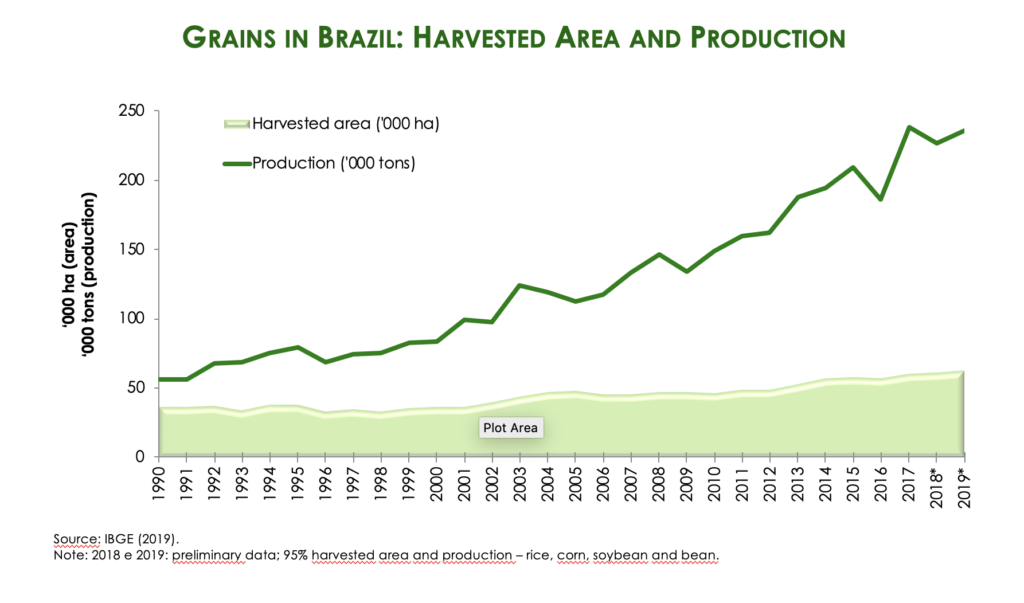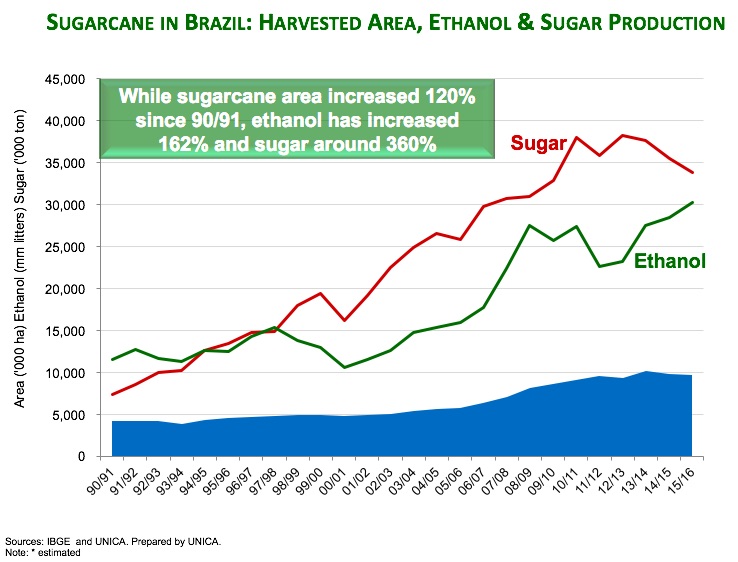Food and Energy
 By 2050, the world’s population will grow by 40 percent which will create another 2.5 billion people who will need to eat and power their lives. During the same time period, global energy needs will likely double. And unless current trends change, carbon dioxide emissions that contribute to global warming could increase by 80 percent. Government officials are searching for low-carbon solutions to provide food and fuel. Sugarcane can help, and Brazil has emerged as a leader in providing both food and energy from its diversified and efficient agricultural sector. Consider the following:
By 2050, the world’s population will grow by 40 percent which will create another 2.5 billion people who will need to eat and power their lives. During the same time period, global energy needs will likely double. And unless current trends change, carbon dioxide emissions that contribute to global warming could increase by 80 percent. Government officials are searching for low-carbon solutions to provide food and fuel. Sugarcane can help, and Brazil has emerged as a leader in providing both food and energy from its diversified and efficient agricultural sector. Consider the following:
Production of both food and biofuels has increased significantly in Brazil. In the last 20 years, the volume of sugarcane harvested and processed in Brazil has almost tripled to meet rising demand for sugarcane ethanol and bioelectricity. During that time, there has been no drop in Brazilian food production. In fact, Brazil’s grain production doubled during the past ten years. Besides sugar and ethanol, Brazil is the world’s leading exporter of beef, coffee, orange juice and poultry. The country is not just feeding itself better but also much of the world with its high-productivity agriculture.

Sugarcane already does a lot with a little land. Sugarcane uses a very small amount of land when compared to other agricultural activities. Ethanol production currently occupies 4.6 million hectares of farmland, which is only 1.4 percent of Brazil’s 330 million hectares of agricultural land (arable land and pastures). Yet from this small portion of land, Brazil has been able to replace 46 percent of its gasoline needs with sugarcane ethanol while also exporting ethanol to the United States, Europe and other markets. Sugarcane for ethanol production requires less than one-quarter of the land used for corn, one-eighth of the amount for soybean production, and one-thirty fifth of the land for cattle ranching.
And plenty of land is available for sugarcane to expand. There is more than enough land available for sugarcane expansion without encroaching on other economic activities.
IN BRAZIL – Over the next decade, Brazilian sugarcane production is estimated to double. The country’s agro-ecological zoning regulations limit the amount of land to be used for sugarcane to 64.7 million hectares, or about 7.5 percent of Brazilian territory. Still, the area available for sugarcane expansion in Brazil is almost nine times larger than what is currently under cultivation. More than half of that future expansion would occur on degraded pastures where cultivating sugarcane would actually improve the carbon balance.
AROUND THE WORLD – According to the Food and Agriculture Organization of the United Nations (FAO), only 10 percent of the world’s land that is available and suitable for cane production is actually used for sugarcane cultivation. More than 100 tropical countries – many of them needing expanded economic opportunities – have the capability to produce sugarcane ethanol. This industry would create rural jobs, increase access to electricity, and reduce dependency on oil imports in the many of the world’s poorest countries.
Technological advances continue to increase productivity and yield from existing cropland. These productivity gains help squeeze more ethanol from the same amount of land. Enhanced sugarcane varietals have already improved ethanol production by increasing sucrose levels 20 percent. With new cellulosic hydrolysis technology, productivity is expected to rise by one-third.
Other factors besides biofuels are driving up agricultural prices. Recent price spikes in agricultural commodities can be explained by a combination of several factors. They include: rapidly rising oil prices, adverse weather conditions, devaluation of the dollar, speculation in agricultural markets, and increased food demand due to population and economic growth, particularly in Asia.
Climate change threatens food security far more than sugarcane ethanol. Climate change threatens to disrupt weather patterns and hydrological cycles. These changes would severely affect agricultural production. In contrast, sugarcane ethanol is a clean, renewable fuel that produces on average 90 percent fewer carbon dioxide emissions than oil and can be an important tool in the fight against climate change.
LEARN MORE
The following reports provide more detailed information about this important issue:
- Reconciling food security and bioenergy: priorities for action – IFPRI, 06/2016
- Biofuels and Food Security – A report by the High Level Panel of Experts on Food Security and Nutrition of the Committee on World Food Security, 06/2013
- The European Commission report on the implementation of the EU Renewable Energy Directive – 03/2013
- The Impact of Ethanol Use on Food Prices and Greenhouse Gas Emissions – Congressional Budget Office, 04/2009
- The Impact of Biofuels – Fundação Getulio Vargas, 11/2008
- The Challenge of Biofuels – José Goldemberg, 10/2008
- The Impact of Biofuels on Commodity Prices – Simone Pfuderer and Maria del Castillo, DEFRA 4/2008
- The State of Food and Agriculture – FAO, 2008
LEADING THE WAY

